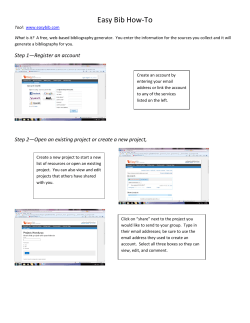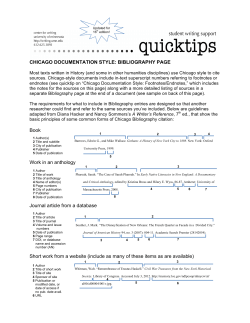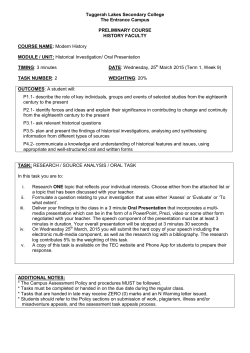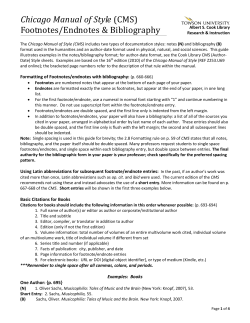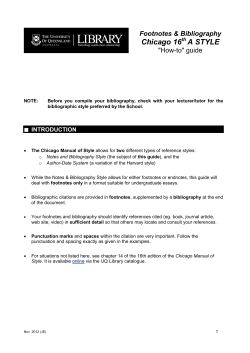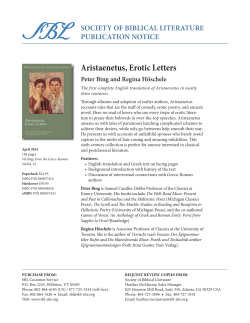
REFERENCING GUIDE: SBL STYLE
REFERENCING GUIDE: SBL STYLE School of Ministry, Theology and Culture This document has been prepared as an introductory guide only. Further information can be found in: The SBL Handbook of Style: For Biblical Studies and Related Disciplines. 3rd ed. Atlanta: SBL Press, 2014 (available from the Tabor Adelaide library). Prepared by Cheryl Turnbull REFERENCING GUIDE: SBL STYLE Page 1 CONTENTS Contents ................................................................................................................................................................................................................................................................. 2 PART 1: Format, Style and General Questions ………………………………………............................................................................................................................................................. 3 PART 2: SBL Style Examples: Footnotes and Bibliography ………………………............................................................................................................................................................ 6 Books ...................................................................................................................................................................................................................................................................... 6 Journal Articles ....................................................................................................................................................................................................................................................... 9 Newspaper Articles ........................................................................................................................................................................................................ ...................................... 10 Internet/Websites ............................................................................................................................................................................................................................................... 10 Lecture Notes, Tabor Adelaide Texts and Other Personal Sources ..…................................................................................................................................................................. 10 Audio-Visual and Other Non-Book, Non-Journal Media ...................................................................................................................................................................................... 11 Miscellaneous Sources ........................................................................................................................................................................................................................................ 13 Example of In-Text Citations and Footnotes ...................................................................................................................................................................................................... 14 Example of a Bibliography …………………............................................................................................................................................................................................................... 15 Appendix 1 - Abbreviations for Books of the Bible ……........................................................................................................................................................................................ 17 REFERENCING GUIDE: SBL STYLE Page 2 PART 1: FORMAT, STYLE AND GENERAL QUESTIONS What is SBL? SBL Style Why use footnotes and how are they formatted? How do I format a Bibliography? SBL stands for the Society of Biblical Literature and its publication manual is the standard for the writing and referencing style in Religious Studies faculties in many universities and colleges across the world. SBL uses footnotes and a Bibliography to reference material in your work. Each of these is explained below. Footnotes provide immediate access to the source of information or expand on a piece of information in the text. Your word processing package will have the facility to produce footnotes. See Part 2 for formatting. In the footnotes the first time a particular book, journal article or other source is referenced it is always written in full. With subsequent reference to that particular source it is abbreviated or the word “Ibid” used if it follows straight after in a consecutive footnote. Example of footnotes: 1 Eric Law, Inclusion: Making Room for Grace (St Louis, MO: Chalice Press, 2000), 27. 6 Law, Inclusion, 30. 7 Ibid, 32-37. In Part 2 examples of left a first and also subsequent footnote havesecond been given. Begin the entry at the margin and ause double spacing. Indent and subsequent lines (hanging indent). List entries alphabetically by the first letter of the reference (usually the author’s surname, but sometimes a title if author is unknown). If there is more than one book for an author then list in date order. What needs to be included in the All sources of quotations and information that you have used in your writing needs to be acknowledged formally. This includes footnotes and Bibliography? paraphrased information where you have reworded the idea from a source, so it is not directly quoted, but the concept has been adopted from the source. Ideas of your own or ideas that are considered common knowledge in the field of study do not need to be referenced. Quotations What is not included in the from the Bible are not included in the footnotes or Bibliography but are acknowledged in an in-text citation. footnotes and Bibliography? Citing names in footnotes and in Wherever possible state a person’s first name or the name they are best known by in full and use initials for other names. the Bibliography Examples: John C. Jones, or F. Susan Miller. Some people are simply known by their initials and use them in authorship, so in this case use only the initials. If you can’t find the first name in all searches, then the initial is acceptable. What is plagiarism? Plagiarism is the use of other people’s work without appropriate acknowledgement. This Guide explains how to acknowledge sources used in your writing using SBL Style. Plagiarism is a serious offence with serious consequences (see current Tabor Adelaide Student Handbook under Academic Misconduct). REFERENCING GUIDE: SBL STYLE Page 3 What changes are there to SBL style for the Australian context? Very few changes are necessary, except for: • Australian spelling in all but quotations from American text or titles. • Addition of Australian states to the place of publication if the state is not obvious. For example, there is no need to add the state after Melbourne, but it would be sensible for Millswood, SA. For texts from other countries follow a similar principle. For example Boston and London stand alone, but Cheltenham, UK and Grand Rapids, MI would be sensible. • For Australian spelling and contemporary usage you may also consult The Macquarie Dictionary, 6th ed., Sydney: Macquarie Dictionary Publishers, 2013; and for editing conventions consult the Style Manual for Authors, Editors and Printers, 6th ed., rev. by Snooks & Co., Milton, QLD: John Wiley & Sons, 2002. Adapting to SBL Style The referencing for the section Audio-Visual and Other Non-Book, Non-Journal Media has been adapted to fit the SBL style as they are not included in the Handbook. What are the best sources for my This will vary according to the task, so be guided by your lecturer. As a general rule, textbooks and articles from professional assignments? journals are most highly valued. These may be either print or electronic versions. The wide range of sources represented in this guide may be used for different purposes, most often with a core of relevant books and journal articles. Popular texts, websites and personal communication are more often illustrative of points that are supported by more solid research, rather than being regarded as authoritative sources on their own. How many references should be used? When should page numbers be used? This will vary with the subject and type of assignment. Check with your lecturer or consult your subject description for specific requirements. Page numbers should always be cited in-text, when available, for direct quotations. Paragraph numbers or headings may be used where no page numbers are available. Page numbers may be used for paraphrased ideas (where you have rewritten an idea in your own words, but drawn heavily on a specific part of your source text). Page numbers are not needed where your paraphrase draws upon multiple parts of a source text or describes the gist of an entire text. Page numbers should be used in your footnotes or Bibliography. What is the purpose of an Appendix (plural, Appendices)? Appendices are for relevant supplementary material not appropriate for inclusion in the body of the text, such as interview questions, a table or other data used for analysis, or essential background information. Appendices are usually brief. If more than one, they should be labelled Appendix A, Appendix B, etc. Appendices are attached AFTER the Bibliography. Sources cited in Appendices are referenced in the same way as the body of the text, by using footnotes and the Bibliography. Reference to the Appendices can be made in the body of the text. For example: (see Appendix) or (see Appendix B). Appendices do not need to be double spaced. A secondary source is one cited in the text of another author. For example, in an article by Williams, written in 2009, there is reference to the work of Clay, who wrote in 2001. If you use the information from Clay, this should be referenced as a secondary source. For higher levels of academic study, it is preferable to go to the original source to ensure that you understand the context of the original work. What is a secondary source and how do you cite it? REFERENCING GUIDE: SBL STYLE Page 4 How do I reference a work if no If available, use the organisation‘s name as author. Use double quotation marks if you are referring to the title of an article. author is provided? How do I cite an article or A course reader is made up of different types of sources. Cite each reading according to the source. chapter in a Tabor Adelaide book of readings or uploaded online on the subject webpage? What is a DOI and how is it referenced? A Digital Object Identifier (DOI) is a unique and permanent name assigned to an individual electronic work and should be provided in the reference where it is available. This alphanumeric string is usually located on the first page of the article. If no DOI is available, provide the URL information in the reference. See Part 2 for details of how to reference. What font and spacing is used for The font and size are not specified, but a simple clear font, size 12, would normally be used for assignments. Double spacing is assignments? required for normal text, but may be altered for tables or other specialised formats. Your Bibliography should be double spaced, set out as in this guide, with the first line at the margin, and second and subsequent lines of each entry indented by approximately one centimetre. Footnotes should be single spaced. Are paragraphs indented? Yes. Indent paragraphs by one tab space and do not leave more than the standard double spacing between paragraphs. In an assignment, how much At Tabor Adelaide the general rule is that up to 10% of an assignment may consist of direct quotation. Quotes are usually included in direct quotation can I use? the total word count, but consult your lecturer if in doubt. How should I format quotations? Quotations of less than 40 words should be integrated into the paragraph, enclosed by double quotation marks and an in-text citation included in brackets. The full stop is placed after the closing bracket. Quotations of 40 words or more should be formatted as a block (next item). What is a block quote? Any quotation of 40 words or more should be formatted as a block: no quotation marks; single spaced; whole block indented and left aligned; and same size font as the body of the text. Citation as for other quotations. What is included/not included in The Bibliography, Appendices, words on maps, graphs or inserted tables are NOT included in the word count. Normally an automatic the word count? count from the first word of the first paragraph to the last word of the final paragraph would be taken as sufficiently accurate. How do you cite the Bible and It is not necessary to list the Bible or the Qur’an or other classical religious works in the footnotes or Bibliography. However, in the first citation indicate the version you used. For example: The researchers consulted the Bible, KJV to provide items for the other classic works? development of their religious values assessment. Example of a direct quote: The Bible enumerates these virtues: “And now these three remain: faith, hope and love. But the greatest of these is love” (1-Cor 13:1, NIV) or The Qur’an 5:3 specifies some dietary restrictions, such as forbidding Muslims to eat “the flesh of swine.” Books without chapters should be spelled out. Examples: First Corinthians has a lot to teach us. The passage, 1-Cor 5:6, is considered crucial. See Appendix 1 for how to abbreviate books of the Bible and page 122 of The SBL Handbook of Style for how to abbreviate versions of the Bible. How do I use nouns referring to God or the Trinity? REFERENCING GUIDE: SBL STYLE Nouns traditionally used as alternative names for God or the persons of the Trinity are capitalised. For example: Father God, Lamb of God, Lord of Lords, Messiah or Word. Less often used names can be lower case. For example: bread of life or light of the world. Pronouns referring to God, such as “he”, should not be capitalised. Page 5 Can I use acronyms in place of full names of organisations? How do I cite foreign words? The full name of the organisation should be used the first time it is mentioned in-text, in the footnotes and also in the Bibliography. Usually the acronym is inserted in brackets after the first mention in-text, if it is to be used in subsequent discussion. The acronym may be used in subsequent citations. For example: The World Council of Churches (WCC) has released a report on Mission. Further discussion of the WCC report was undertaken. Foreign words and phrases are typically italicised. Example: the chapter focused on missio Dei. PART 2: SBL REFERENCING EXAMPLES: FOOTNOTES AND BIBLIOGRAPHY NOTE: The following Guide is formatted with SINGLE SPACING, font size 11 to save space (and paper in printed editions). For your assignments please use DOUBLE SPACING and font size 12 for the body of the text and the Bibliography, and size 11 for the footnotes. Examples of subsequent abbreviated footnotes have been given where appropriate as the last entry in each Footnote Example. BOOKS MATERIAL TYPE Book with single author FOOTNOTE EXAMPLE 1 Hugh Mackay, Advance Australia Where? Why We’ve Changed, How We’ve Changed and What Will Happen Next (Sydney: Hachette Australia, 2007), 24. Subsequent footnotes: 4 Mackay, Advance Australia Where?, 28. 5 Ibid, 29-31. BIBLIOGRAPHY EXAMPLE Mackay, Hugh. Advance Australia Where? Why We’ve Changed, How We’ve Changed and What Will Happen Next. Sydney: Hachette Australia, 2007. Book with two or three authors 2 Mark L. Branson and Juan F. Martinez, Churches, Culture and Leadership: A Practical Theology of Congregations and Ethnicities (Downers Grove, IL: IVP Academic, 2011), 424-428. 3 Julie Perfect and Steve Perfect, Ministry and Married Life (Las Vegas: Bliss Books, 2000), 75-95. 7 Perfect and Perfect, Ministry and Married Life, 80. Branson, Mark L., and Juan F. Martinez. Churches, Culture and Leadership: A Practical Theology of Congregations and Ethnicities. Downers Grove, IL: IVP Academic, 2011. Perfect, Julie, and Steve Perfect. Ministry and Married Life. Las Vegas: Bliss Books, 2000. Book with four or more authors 5 Scott, Bernard B., Margaret Dean, Kristen Sparks, and Frances LeZar. Reading New Testament Greek. Peabody, MA: Hendrickson, 1993. REFERENCING GUIDE: SBL STYLE Bernard B. Scott et al., Reading New Testament Greek (Peabody, MA: Hendrickson, 1993), 22-32. 9 Scott et al., Reading New Testament Greek, 30. Page 6 Book with no author Multiple works by same author, published in different years Multiple works by same author, published in same year 13 The Book Society, Style Manual for Busy People (Unley, SA: ABC Press, 2006), 108-110. OR 14 The Macquarie Dictionary, 6th ed. (Sydney: Macquarie Dictionary Publishers, 2013). 17 The Macquarie Dictionary. 4 Michael Green, Evangelism in the Early Church (Grand Rapids, MI: Eerdmans, 1970), 94-99. 8 Michael Green, Evangelism Through the Local Church (London: Hodder and Stoughton, 1990), 2-6. 10 Green, Evangelism Through the Local Church, 3. 11 Ibid, 5. 3 Penny South, What Ministers Need to Know About Grace (Melbourne: ACE Press, 2009a), 14. 7 Penny South, What Ministers Need to Know About Peace (Melbourne: ACE Press, 2009b), 6-9. A translated book 10 Book with one editor 3 Book with two or three editors Book with four or more editors Book with both author and editor/s REFERENCING GUIDE: SBL STYLE Wilhemena Schmidt, An Introduction to the Old Testament, trans. Peter Orr (Sydney: Better Books, 1994), 36-40. 13 Schmidt, An Introduction to the Old Testament, 39. Moises M. Silva, ed., Foundations of Contemporary Interpretation (Grand Rapids, MI: Zondervan, 1996), 27. 2 Wendy C. Hall and Steve B. Smith, eds., Church Growth in Europe (London: Pilgrim Press, 2007), 5. 6 Hall and Smith, Church Growth, 7. 3 John Green et al., eds., Understanding Noah (Millswood, SA: Hoorah Books, 2015), 33-55. 7 Green et al., Understanding Noah, 40-45. 6 Robyn Hood, Giving in Churches: An Analysis, ed. John Little and Sue Sherriff (Nottingham, UK: Sherwood Press, 1990), 45-47. 8 Hood, Giving in Churches, 46. The Book Society. Style Manual for Busy People. Unley, SA: ABC Press, 2006. OR The Macquarie Dictionary. 6th ed. Sydney: Macquarie Dictionary Publishers, 2013. Green, Michael. Evangelism in the Early Church. Grand Rapids, MI: Eerdmans, 1970. ----. Evangelism Through the Local Church. London: Hodder and Stoughton, 1990. South, Penny. What Ministers Need to Know About Grace. Melbourne: ACE Press, 2009a. ----. What Ministers Need to Know About Peace. Melbourne: ACE Press, 2009b. Schmidt, Wilhemena. An Introduction to the Old Testament. Translated by Peter Orr. Sydney: Better Books, 1994. Silva, Moises M., ed. Foundations of Contemporary Interpretation. Grand Rapids, MI: Zondervan, 1996. Hall, Wendy C., and Steve B. Smith, eds. Church Growth in Europe. London: Pilgrim Press, 2007. Green, John, Mary White, Julie Black, and Mark Rainbow, eds. Understanding Noah. Millswood, SA: Hoorah Books, 2015. Hood, Robyn. Giving in Churches: An Analysis. Edited by John Little and Sue Sherriff. Nottingham, UK: Sherwood Press, 1990. Page 7 Article in an edited volume 7. Harold Marsh, “A Very Short History of Judaism,” in Potted World Religions, ed. Sue Happy (Adelaide: Optimistic Books, 2014), 35. 10. Marsh, “A Very Short History” (Happy), 36. Marsh, Harold. “A Very Short History of Judaism.” Pages 3436 in Potted World Religions. Edited by Sue Happy. Adelaide: Optimistic Books, 2014. Book with more than one publisher 4 Joe Bloggs, How to Love Study: A Guide (London: Born Books; Brighton, SA: Academic Press, 2010), 24-25. Bloggs, Joe. How to Love Study: A Guide. London: Born Books; Brighton, SA: Academic Press, 2010. 3 Bruce Findlay, How to Write Psychology Research Reports and Essays, 4th ed. (Frenchs Forest, NSW: Pearson Prentice Hall, 2006), 99-108. OR 4 Joseph Blenkinsopp, A History of Prophesy in Israel, rev and enl. ed. (Louisville, KY: Westminster John Knox, 1996), 22-24. Findlay, Bruce. How to Write Psychology Research Reports and Essays. 4th ed. Frenchs Forest, NSW: Pearson Prentice Hall, 2006. OR Blenkinsopp, Joseph. A History of Prophesy in Israel. Rev and enl. ed. Louisville, KY: Westminster John Knox, 1996. 2 Ellingsen, Mark. Reclaiming Our Roots: An Inclusive Introduction to Church History. Vol. 1. Harrisburg, PA: Trinity Press International, 1999. Book with editions Book with volume numbers Mark Ellingsen, Reclaiming Our Roots: An Inclusive Introduction to Church History, vol. 1 (Harrisburg, PA: Trinity Press International, 1999), 22-32. 3 Book on Kindle or a similar digital format Malcolm Gladwell, Outliers: The Story of Success (New York: Little, Brown and Co, 2008), Kindle edition. E-book with no DOI assigned; downloaded1. 6 Stephen Kaufman, The Akkadian Influences on from internet but NOT Kindle or a Aramaic, AS 19 (Chicago: The Oriental Institute of the similar format University of Chicago, 1974), http://oi.uchicago.edu/ pdf/as19.pdf. 2. 8 Kaufman, The Akkadian Influences. E-book with DOI assigned REFERENCING GUIDE: SBL STYLE 1 Ann E. Killebrew and Margaret Steiner, eds., The Oxford Handbook of the Archaeology of the Levant: c. 8000-332 BCE (Oxford: Oxford University Press, 2014), doi: 10.1093/oxfordhb/9780199212972.001.0001. 7 Killebrew and Steiner, The Oxford Handbook. Gladwell, Malcolm. Outliers: The Story of Success. New York: Little, Brown and Co. 2008. Kindle edition. Kaufman, Stephen. The Akkadian Influences on Aramaic. AS 19. Chicago: The Oriental Institute of the University of Chicago, 1974. http://oi.uchicago.edu/pdf/as19.pdf. Killebrew, Ann E., and Margaret Steiner, eds. The Oxford Handbook of the Archaeology of the Levant: c. 8000332 BCE. Oxford: Oxford University Press, 2014. doi: 10.1093/oxfordhb/9780199212972.001.0001. Page 8 JOURNAL ARTICLES MATERIAL TYPE FOOTNOTE EXAMPLE BIBLIOGRAPHY EXAMPLE Suzie Smith, “Qualities of Cross-Cultural Workers,” Journal of Happy Missionaries 23 (2001): 34-36. 4 Smith, “Qualities of Cross-Cultural Workers,” 35. Smith, Suzie. “Qualities of Cross-Cultural Workers.” Journal of Happy Missionaries 23 (2001): 34-40. It is not necessary to include the issue number if there are page numbers. Cross, Jenny C., Joe Huff, and Peter Peeved. “How to Curb Your Temper.” Journal of Anger Management 3 (1999): 77-89. Journal article with single author 2 Journal article with two or three authors 5 Journal article with four or more authors Chong, Vanessa, Tim O’Hare, Omar Khan, and Neelam Laif. “Observations of International Students.” Education Monthly 11 (1956): 3-34. 6 “The Pain of Being a Caffeine Freak,” New Scientist “The Pain of Being a Caffeine Freak.” New Scientist 172 (2001): 172 (2001): 27. 27. 2 Richard Klimoski and Susan Palmer, “The ADA and the Klimoski, Richard, and Susan Palmer. “The ADA and the Hiring Hiring Process in Organizations,” Consulting Process in Organizations.” Consulting Psychology Journal: Psychology Journal: Practice and Research 45 (1993): Practice and Research 45 (1993): 10-36. doi: 10.1037/106110-36, doi: 10.1037/1061-4087.45.2.10. 4087.45.2.10. 6 Klimoski and Palmer, “The ADA and the Hiring Process.” 12 Tamra Sillick, “Emotional Intelligence and SelfSillick, Tamra. “Emotional Intelligence and Self-Esteem Mediate Esteem Mediate Between Perceived Early Parental Between Perceived Early Parental Love and Adult Love and Adult Happiness,” E-Journal of Applied Happiness.” E-Journal of Applied Psychology 2 (2006): 38Psychology 2 (2006): 38–48, retrieved from 48. Retrieved from http://ojs.lib.swin.edu.au/ http://ojs.lib.swin.edu.au/index.php/ejap. index.php/ejap. 14 Sillick, “Emotional Intelligence.” Journal article with no author Online journal article with DOI assigned Online journal article with no DOI assigned Online journal article with no page numbers REFERENCING GUIDE: SBL STYLE Jenny C. Cross, Joe Huff and Peter Peeved, “How to Curb Your Temper,” Journal of Anger Management 3 (1999): 78. 7 Vanessa Chong et al., “Observations of International Students,” Education Monthly 11 (1956): 30. 6 Jack Williams, “The Victims of Crime,” Sociology Review 17, 4 (2008), retrieved from http://magazines.philipallan.co.uk/ Magazines/ Sociology-Review.aspx. Williams, Jack. “The Victims of Crime.” Sociology Review 17, 4 (2008). Retrieved from http://magazines.philipallan.co.uk/ Magazines/Sociology-Review.aspx. Page 9 NEWSPAPER ARTICLES NEWSPAPER ARTICLES Newspaper article in print REFERENCE LIST EXAMPLE Other, Ann. “Theological Education the Key to a Longer Life.” The Daily Planet (6 January 2013), 14. Newspaper article from a website FOOTNOTE EXAMPLE 7 Ann Other, “Theological Education the Key to a Longer Life,” The Daily Planet (6 January 2013), 14. 11 Other, “Theological Education,” 14. 10 Rick Morton, “The Heat Goes On … and On,” The Australian (7 January 2013), retrieved from http://www.theaustralian.com.au/news/nation/theheat-goes-on-and-on/story-e6frg6nf-22654852677. 13 Morton, “The Heat Goes On.” Newspaper article without author 9 “Saving Power Can Kill,” The Advertiser (7 January 2013), 14. 11 “Saving Power Can Kill,” 14. “Saving Power Can Kill.” The Advertiser (7 January 2013), 14. M ATERIAL TYPE Web document FOOTNOTE EXAMPLE 4 “The One Hundred Most Important Cuneiform Objects,” http://cdli.ox.ac.uk/wiki/doku.php?id= the_one_hundred_most_important_cuneiform_ objects. 7 “The One Hundred Most Important Cuneiform Objects.” BIBLIOGRAPHY EXAMPLE “The One Hundred Most Important Cuneiform Objects.” http://cdli.ox.ac.uk/wiki/doku.php?id=the_one_hundred_ most_important_cuneiform_objects. Blog 9 Not listed in Bibliography. Morton, Rick. “The Heat Goes On … and On.” The Australian (7 January 2013). Retrieved from http://www.theaustralian. com.au/news/nation/the-heat-goes-on-and-on/storye6frg6nf-1226548526778. INTERNET Mark Goodacre, “Jesus’ Wife Fragment: Another Round-Up,” NT Blog, 9 May 2014, http://ntweblog. blogspot.com. 15 Goodacre, “Jesus’ Wife Fragment.” LECTURE NOTES AND OTHER PERSONAL SOURCES MATERIAL TYPE Printed/online lecture notes REFERENCING GUIDE: SBL STYLE FOOTNOTE EXAMPLE 6 David Turnbull, TM4391EV Evangelism (Lecture Notes), School of Ministry, Theology and Culture, Tabor Adelaide, 2010. 10 Turnbull, TM4391EV Evangelism. BIBLIOGRAPHY EXAMPLE Not listed in Bibliography. Page 10 Lecture at Tabor Adelaide Personal communication, interviews, emails and letters 8 Aaron Chalmers, TM5121 Introduction to the Old Testament (Lecture 7, 2013). 10 Chalmers, TM5121 Introduction to the Old Testament. 4 Email (Jenny Spinner), personal communication, 2 September 2014. 7 Email (Jenny Spinner). 9 Interview (Ali Khan by Alia Souk), 3 May 2010. Not listed in Bibliography. Not listed in Bibliography. AUDIO-VISUAL AND OTHER NON-BOOK, NON-JOURNAL MEDIA MATERIAL TYPE DVD Television broadcast Motion picture Music recording Music track from an album REFERENCING GUIDE: SBL STYLE FOOTNOTE EXAMPLE 4 Michael Moore, writer and director, Bowling for Columbine (Melbourne: Umbrella Entertainment, 2003), DVD. 6 Moore, Bowling for Columbine. 7 Rob Anderson and Clive Morgan, producers, 60 Minutes (Washington DC: CBS News, 20 June 2008), television broadcast. 9 Anderson and Morgan, 60 Minutes. 5 Martin Scorsese, producer and Kenneth Lonergan, writer/director, You Can Count on Me (Los Angeles: Paramount Pictures, 2000), Motion picture. 8 Scorsese and Lonergan, You Can Count on Me. 4 St. Laurance Chamber Choir, performers, and N. McEwan, director, Commemoration, Ritual and Performance: The Iberian Connection: Medieval and Renaissance Music from the St Laurence Chamber Choir (Sydney: Centre for Medieval Studies, University of Sydney), CD. 7 St. Laurance Chamber Choir. BIBLIOGRAPHY EXAMPLE Not listed in Bibliography. 2 Not listed in Bibliography. G. Gurrumul Yunupingu, performer, Gopuru on Rrakala (Winnellie, NT: Skinnyfish, 2011), CD. 5 Yunupingu, Gopuru. Not listed in Bibliography. Not listed in Bibliography. Not listed in Bibliography. Page 11 Podcast 6 Mark Ryan, script writer and Andrew Hogan, director, episode 26, Nerdzilla (25 October 2011) (Hobart: ABC Local Radio, 2011), retrieved from http://www.abc.net. au/local/audio/2011/10/ 24/3346730.htm, podcast radio program. 9 Ryan and Hogan, Nerdzilla. 6 A. Hall, How to Study at Oxford University (20 December 2007), retrieved from http://www.youtube.com/watch?v=vxAU88LxLis, video file. Not listed in Bibliography. Online or streaming video 3 Tom Zubrycki, producer and director and Jimmy Chi, writer, Bran Nue Dae: A Musical Journey (2009), retrieved from http://www.kanopystreaming.com, video recording. Not listed in Bibliography. Image in a book 1 My Car Poem in A Passion for Poetry, written and illustrated by Mandy Tunica (Newtown, NSW: PETA, 2005, 117, image. 5 My Car Poem. Not listed in Bibliography. Image online 1 Not listed in Bibliography. Video clip (Youtube) REFERENCING GUIDE: SBL STYLE Human Skeleton, retrieved from http://www. teachpe.com/images/anatomy/skeleton.jpg, 2011, image. 2 Saudi Arabia, retrieved from http://www.worldatlas.com/webimage/countrys /asia/ sa.htm, 2009, topographic map. 3 David Tunbridge, Volunteers of the ACT Bushfire Service Lighting a Back-Burn on the Mount Franklin Road, Brindabella Ranges, on the Night of 11/12 January 2003, retrieved from http://nla.gov.au/ nla.pic-an24954626, online image. 6 Saudi Arabia. 9 Tunbridge, Volunteers of the ACT Bushfire Service. Not listed in Bibliography. Page 12 MISCELLANEOUS SOURCES MATERIAL TYPE Annual report of an organization Paper presented at a conference FOOTNOTE EXAMPLE BIBLIOGRAPHY EXAMPLE 4 World Vision Australia, Annual Report, 2012, World Vision Australia. Annual Report, 2012. Retrieved from retrieved from http://www.worldvision.com.au http://www.worldvision.com.au/aboutus/ Annual /aboutus/ AnnualReportsAndReviews.aspx. ReportsAndReviews.aspx. 6 World Vision Australia, Annual Report, 2012. 7 Susan Niditch, “Oral Culture and Written Niditch, Susan. “Oral Culture and Written Documents.” Documents” (paper presented at the Annual Meeting Paper presented at the Annual Meeting of the New of the New England Region of the SBL (Worcester, MA, England Region of the SBL. Worcester, MA, 25 March 25 March 1994), 13-17. 1994. 9 Niditch, “Oral Culture.” Conference proceedings published 7 Ros Wilkinson, “The Sociology of Religion,” in Sociology ForThis Age, ed. Jack Fourtree and Sue Fifer, paper presented at The Australian Triennial Sociology Conference, Monash University, Melbourne, 24-26 December (Churchill, VIC: Celts Press, 1999) 7-9. 10 Wilkinson, “The Sociology of Religion” (Fourtree and Fifer), 8. Wilkinson, Ros. “The Sociology of Religion.” Pages 2-10 in Sociology For This Age. Edited by Jack Fourtree and Sue Fifer. Paper presented at The Australian Triennial Sociology Conference. Monash University, Melbourne, 24-26 December. Churchill, VIC: Celts Press, 1999. Conference proceedings unpublished 3 Gidley, Vic. “Working Together to Make the Dream a Reality.” Paper presented at the ATSIM Indigenous Health Conference. Wahroonga, NSW, 11-13 October 2000. Thesis published Thesis unpublished REFERENCING GUIDE: SBL STYLE Vic Gidley, “Working Together to Make the Dream a Reality,” paper presented at the ATSIM Indigenous Health Conference, Wahroonga, NSW, 11-13 October 2000. 6 Gidley, “Working Together.” 2 Geoff D. Arnott. Working in Aged Care and Disability Services: An Introduction (Croydon, VIC: Tertiary Press, 2005), 34. Arnott, Geoff D. Working in Aged Care and Disability Services: An Introduction. Croydon, VIC: Tertiary Press, 2005. 4 Wescombe-Down, David. “Working With Gifted and TwiceDavid Wescombe-Down, “Working With Gifted and Exceptional Undergraduate and Postgraduate Education Twice-Exceptional Undergraduate and Postgraduate Students in Australia.” Unpublished Doctoral Dissertation. Education Students in Australia,” unpublished Doctoral Perth, WA: Curtin University, 2013. Dissertation (Perth, WA: Curtin University, 2013). 7 Wescombe-Down, “Working with Gifted and TwiceExceptional Undergraduate and Postgraduate Education Students in Australia.” Page 13 EXAMPLE OF IN-TEXT CITATIONS AND FOOTNOTES This guide is designed to help you understand how to format your essays and reference your work in order to avoid the dangers of plagiarism.1 It also explains the SBL referencing system.2 Some of the basic rules are that if you use a short quote you write Smith observes that “it is often hard to help others fit in.”3 Or if you wish to use a longer quote it is blocked. Inclusion is the ultimate aim: Inclusion is a discipline of extending our boundary to take into consideration another’s needs, interests, experience, and perspective, which will lead to clearer understanding of ourselves and others, fuller description of the issues at hand, and possibly a newly negotiated boundary of the community to which we belong.4 As you can see, footnotes are used to help clarify a point or to reference your work so not only do you avoid plagiarism, you allow those who read your work to look further at the research you have highlighted. As a rule, all references in your footnotes should also be included in the Bibliography, see this Guide for exceptions. NOTE THAT THE BIBLIOGRAPHY IS ON A NEW PAGE 1 Plagiarism is the practice of taking someone else’s work or ideas and passing them off as your own. SBL stands for the Society of Biblical Literature and its publication manual is the standard for the writing and referencing style in Religious Studies faculties in many universities and colleges across the world. 3 Joan Smith, “Helping Everybody to Belong,” Journal of the Masses 6 (2013): 34-36. 4 Eric Law, Inclusion: Making Room for Grace (St Louis, MO: Chalice Press, 2000). 2 REFERENCING GUIDE: SBL STYLE Page 14 EXAMPLE OF A BIBLIOGRAPHY Booker, Mike, and Mark Ireland. Evangelism - Which Way Now? An Evaluation of Alpha, Emmaus, Cell Church and Other Contemporary Strategies for Evangelism. London: Church House, 2003. Brueggemann, Walter. Biblical Perspectives on Evangelism: Living in a Three-Storied Universe. Nashville: Abingdon Press, 1993. Chapman, John. Know and Tell the Gospel. Rev. ed. Sydney: Hodder and Stoughton, 1984. -----. Setting Hearts on Fire. Kingsford, NSW: Matthias Media, 1999. Chester, Tim. Good News to the Poor: Sharing the Gospel Through Social Involvement. Leicester, UK: IVP, 2004. Hall, Wendy C., and Steve B. Smith, eds. Church Growth in Europe. London: Pilgrim Press, 2007. Hybels, Bill. Just Walk across the Room: Simple Steps Pointing People to Faith. Grand Rapids, MI: Zondervan Publishing House, 2006. Hybels, Bill, and Mark Mittelberg. Becoming a Contagious Christian. Grand Rapids, MI: Zondervan Publishing House, 1994. Kaufman, Stephen. The Akkadian Influences on Aramaic. AS 19. Chicago: The Oriental Institute of the University of Chicago, 1974. http://oi.uchicago.edu/pdf/ as19.pdf. Killebrew, Ann E., and Margaret Steiner, eds. The Oxford Handbook of the Archaeology of the Levant: c. 8000-332 BCE. Oxford: Oxford University Press, 2014. doi: 10.1093/oxfordhb/9780199212972.001.0001. Law, Eric. Inclusion: Making Room for Grace. St Louis, MO: Chalice Press, 2000. Marsh, Harold. “A Very Short History of Judaism.” Pages 34-36 in Potted World Religions. Edited by Sue Happy. Adelaide: Optimistic Books, 2014. Scott, Bernard B., Margaret Dean, Kristen Sparks, and Frances LeZar. Reading New Testament Greek. Peabody, MA: Hendrickson, 1993. REFERENCING GUIDE: SBL STYLE Page 15 Smith, Joan. “Helping Everybody to Belong.” Journal of the Masses 6 (2013): 34-36. Sillick, Tamra. “Emotional Intelligence and Self-Esteem Mediate Between Perceived Early Parental Love and Adult Happiness.” E-Journal of Applied Psychology 2 (2006): 38-48. Retrieved from http://ojs.lib.swin.edu.au/ index.php/ejap. The Macquarie Dictionary. 6th ed. Sydney: Macquarie Dictionary Publishers, 2013. REFERENCING GUIDE: SBL STYLE Page 16 APPENDIX 1 – ABBREVIATIONS FOR BOOKS OF THE BIBLE OT - Old Testament Jer - Jeremiah John - John Gen - Genesis Lam - Lamentations Acts - Acts Exod - Exodus Ezek - Ezekiel Rom - Romans Lev - Leviticus Dan - Daniel 1-2 Cor - 1-2 Corinthians Num - Numbers Hos - Hosea Gal - Galatians Deut - Deuteronomy Joel - Joel Eph - Ephesians Josh - Joshua Amos - Amos Phil - Philippians Judges - Judges Obad - Obadiah Col - Colossians Ruth - Ruth Jonah - Jonah 1-2 Thess - 1-2 Thessalonians 1-2 Sam - 1-2 Samuel Mic - Micah 1-2 Tim - 1-2 Timothy 1-2 Kgs - 1-2 Kings Nah - Nahum Titus - Titus 1-2 Chr - 1-2 Chronicles Hab - Habakkuk Phlm - Philemon Ezra - Ezra Zeph - Zephaniah Heb - Hebrews Neh - Nehemiah Hag - Haggai Jas - James Esth - Esther Zech - Zechariah 1-2 Pet - 1-2 Peter Job - Job Mal - Malachi 1-2-3 John - 1-2-3 John Ps/Pss - Psalms Jude - Jude Prov - Proverbs NT - New Testament Eccl - Ecclesiastes Matt - Matthew Song - Song of Solomon Mark - Mark Isa - Isaiah Luke - Luke REFERENCING GUIDE: SBL STYLE Rev - Revelation Page 17
© Copyright 2025

